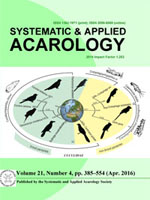In some biological programs, multiple predator species are released to control a single prey species. While in some cases release of multiple species may provide a better control, in other cases species may interact with each other with possible negative outcome on biological control program. In this study, intraguild predation was assessed among three phytoseiid species, Amblyseius swirskii (Athias-Henriot), Neoseiulus barkeri (Hughes) and Phytoseiulus persimilis Athias-Henriot under laboratory conditions in either absence or presence of Tetranychus urticae Koch and/or pollen. Adult females of all three predator species exhibited higher predation rate on larvae than on the other immature stages. Phytoseiulus persimilis did not feed on the nymphal stages of the other two phytoseiid species, while A. swirskii and N. barkeri fed on all juvenile stages of the two others. Females of A. swirskii consumed more phytoseiid larvae than did the other two species. However, the predation of females of the three species on immature stages decreased significantly when prey/food was added to experimental units. Our results suggest that the three species, A. swirskii, N. barkeri and P. persimilis are potentially prone to intraguild interactions with each other, and A. swirskii is the strongest intraguild predator. The results of this study may be helpful in selecting effective biological control strategies against spider mites.
How to translate text using browser tools
3 March 2016
Intraguild predation among three phytoseiid species, Neoseiulus barkeri, Phytoseiulus persimilis and Amblyseius swirskii
Bahador Maleknia,
Yaghoub Fathipour,
Mahmoud Soufbaf
ACCESS THE FULL ARTICLE

Systematic and Applied Acarology
Vol. 21 • No. 4
April 2016
Vol. 21 • No. 4
April 2016
complex trophic interaction
Extraguild prey
food source
phytoseiid mites




